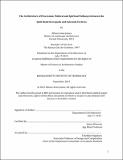The architecture of procession : political and spiritual pathways between the Qutb Shahi Necropolis and Golconda Fortress
Author(s)
James, Allison Anne
DownloadFull printable version (85.69Mb)
Alternative title
Political and spiritual pathways between the Qutb Shahi Necropolis and Golconda Fortress
Other Contributors
Massachusetts Institute of Technology. Department of Architecture.
Advisor
James Wescoat.
Terms of use
Metadata
Show full item recordAbstract
This thesis is an exploration of the role of processional architecture in articulating the Qutb Shahi necropolis in southern India at the beginning of the Qutb Shahi dynasty (mid-16th C). More precisely, it analyzes two processional pathways that connected Golconda Fortress to the Qutb Shahi necropolis. The pathways were significant because of the political and spiritual qualities they held. They extended northward toward a Sufi shrine and water complex, and beyond that to the antecedent capital of Bidar 135 kilometers to the northwest. Later, these paths would be important in connecting Golconda and the necropolis with the city of Hyderabad founded in 1591. Methods used to examine these pathways are a mix of historical, topographical, visual, and spatial investigations as they relate to the wider political and spiritual patronages of the sultanate. The first part of each chapter provides context of the wider patronage of each sultan. The second part explores the landscape of procession by moving through the pathways as they were laid out. The third part shows how the series of structures take advantage of the natural topography by framing key "views" of the processional ways and thereby connect Golconda to the necropolis. The final section of each chapter shows how these larger perspectives help to interpret the spatial layout of tombs on the necropolis. Through this analysis of four spatial relationships, the thesis shows how the tomb complex was defined by an initial pair of orientations to the East and South, which shifted to a primary emphasis to the South during the reign of Sultan Ibrahim Quli Qutb Shah (1550-1580), and back to the East during the reign of Sultan Muhammad Quli Qutb Shah (1580-1611.) As the Sultanate evolved, the pathways became, and remained, as important as the critical monuments of spiritual and political significance that they connected.
Description
Thesis: S.M. in Architecture Studies, Massachusetts Institute of Technology, Department of Architecture, 2015. Cataloged from PDF version of thesis. Page 105 blank. Includes bibliographical references (pages 97-104).
Date issued
2015Department
Massachusetts Institute of Technology. Department of ArchitecturePublisher
Massachusetts Institute of Technology
Keywords
Architecture.